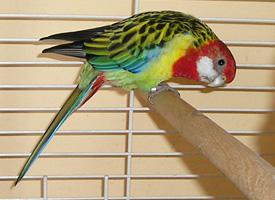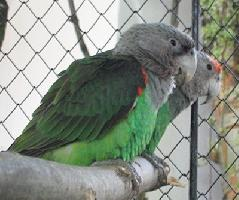
Poids et mesures
| Longueur | 23 cm |
|---|---|
| Poids | de 125 à 170 g |
Description de l'animal
The Senegal parrot (Poicephalus senegalus) is a captivating bird species that belongs to the Poicephalus genus, which is notable for comprising some of the most beloved pet parrots. Native to the savanna and woodland regions of West Africa, this bird is distinguished by its compact size, vivid coloration, and engaging personality, making it a favored choice among avian enthusiasts.Physically, the Senegal parrot is a small to medium-sized bird, measuring approximately 23 centimeters in length and weighing around 120 to 170 grams. One of the most striking features of its appearance is its color palette. The bird's plumage is primarily a bright, iridescent green that covers the majority of its body, serving as a perfect camouflage against the lush foliage of its natural habitat. The underparts and the chest area display a unique V-shaped vest of a vibrant yellow to orange hue, which vividly contrasts with the green and adds to the bird's charm. The bird's head is adorned with a grayish crown, and its beak is strong and curved, typical of parrot species, and is colored black. The eyes are surrounded by a narrow, unfeathered ring, which gives them a striking appearance against their plumage.
One of the most endearing qualities of the Senegal parrot is its personality. Known for being relatively calm and quiet compared to other parrot species, it makes an excellent companion for those living in apartments or shared spaces. They are known to form strong bonds with their owners, displaying affection and loyalty. However, like all parrots, Senegal parrots require social interaction and mental stimulation to thrive. They are intelligent and curious birds, capable of learning a variety of tricks and, in some cases, developing a modest vocabulary.
In the wild, Senegal parrots live in flocks and have a varied diet consisting of fruits, seeds, grains, and the occasional insect. In captivity, it is crucial to replicate this diet as closely as possible to ensure their health and well-being. A diet rich in variety not only provides essential nutrients but also offers mental stimulation, as the bird forages and explores different textures and flavors.
Senegal parrots have a relatively long lifespan, with many living up to 30 years or more in captivity with proper care. This longevity requires a long-term commitment from their owners, encompassing proper nutrition, regular veterinary check-ups, and ample opportunities for exercise and mental engagement.
Their vocalizations in the wild include a range of whistles, squawks, and chirps, which in the home environment can be quite pleasant and not overly loud, making them suitable for those who prefer a less noisy companion. However, they are capable of louder calls, especially if seeking attention or expressing displeasure.
The conservation status of the Senegal parrot is currently listed as Least Concern by the International Union for Conservation of Nature (IUCN), indicating that they are not presently at significant risk of extinction in the wild. Nevertheless, habitat destruction and the pet trade pose ongoing threats to their populations, emphasizing the importance of responsible breeding and ownership practices.
In summary, the Senegal parrot is a fascinating and delightful bird, both in appearance and temperament. Its manageable size, engaging personality, and beautiful plumage make it a popular choice for pet owners around the world. With the proper care, these birds can provide companionship and joy for many years, making them a cherished member of any family or individual fortunate enough to have them.
Animaux similaires
Nouvelles photos d'animaux
Top 10 des animaux
- Dolphin gull (Leucophaeus scoresbii)
- Diana monkey (Cercopithecus diana)
- Moustached guenon (Cercopithecus cephus)
- Galápagos tortoise (Geochelone nigra complex)
- Stone loach (Barbatula barbatula)
- Japanese macaque (Macaca fuscata)
- Russian tortoise (Testudo horsfieldii)
- Greek tortoise (Testudo graeca)
- Common flying dragon (Draco volans)
- Vendace (Coregonus albula)


